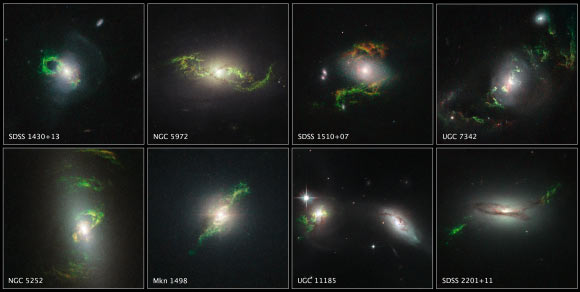Astronomers using the Hubble Space Telescope have photographed eight unusual looped structures – ephemeral ‘ghosts’ of quasars that flickered to life and then faded.

This Hubble image shows ghostly green filaments, lying within galaxy 2MASX J22014163+1151237. This filament was illuminated by a blast of radiation from a quasar – a very luminous and compact region that surrounds the supermassive black hole at the center of its host galaxy. Its bright green hue is a result of ionized oxygen, which glows brightly at green wavelengths. Image credit: NASA / ESA / W. Keel, University of Alabama.
The eight objects orbit their host galaxies – NGC 5972, NGC 5252, Mrk 1498, UGC 11185, UGC 7342, the Teacup (also known as 2MASX J14302986+1339117), 2MASX J15100402+0740370, and 2MASX J22014163+1151237 – and glow in a bright and eerie goblin-green hue.
“Quasars are not bright enough now to account for what we’re seeing; this is a record of something that happened in the past,” said team member Dr Bill Keel of the University of Alabama, Tuscaloosa.
These objects, described in a paper accepted for publication in the Astronomical Journal (arXiv.org preprint), are immense in size, spanning tens of thousands of light-years. They were illuminated by a blast of radiation from a quasar – a very luminous and compact region that surrounds a supermassive black hole at the center of a galaxy.
Galactic material falls inwards towards the central black hole, growing hotter and hotter, forming a bright and brilliant quasar with powerful jets of particles and energy beaming above and below the disc of infalling matter.
In each of these objects a quasar beam has caused once-invisible filaments in deep cosmos to glow through photoionization.
Oxygen, helium, nitrogen, sulfur and neon in the filaments absorb light from the quasar and slowly re-emit it over many thousands of years. Their unmistakable emerald hue is caused by ionized oxygen, which glows green.

These Hubble images reveal a set of greenish, looping, spiral, and braided shapes around eight active galaxies. These huge knots of dust and gas appear greenish because they are glowing predominately in light from photoionized oxygen atoms. Each galaxy hosts a bright quasar that may have illuminated the structures. The ethereal wisps outside the host galaxies were blasted, perhaps briefly, by powerful ultraviolet radiation from a supermassive black hole at the core of each galaxy. Material falling into the black hole was heated to a point where a brilliant searchlight beam traveled into deep space. Because the quasars are not bright enough now to account for the present glow of the blobs, they may be a record of something that happened in the past inside the host galaxies. The black holes may have been fueled through collisions between two galaxies, and the filaments may be forensic evidence for material tattered in the collision. Image credit: NASA / ESA / W. Keel, University of Alabama.
The first object of this type was discovered in 2007 in the galaxy IC 2497 by Dutch amateur astronomer Hanny van Arkel, while she was participating in an online project called Galaxy Zoo.
Assuming that this object, dubbed Hanny’s Voorwerp, could offer insights into the puzzling behavior of active galaxies, Galaxy Zoo scientist Dr Keel initiated a search for other similar phenomenon. The project had 200 volunteers look at archival data of 15,000 galaxies hosting quasars.
Dr Keel’s team took the galaxies that looked the most promising and further studied them by dividing their light into its component colors through a process called spectroscopy.
In follow-up observations from Kitt Peak National Observatory and the Lick Observatory, the team found 20 galaxies that had gas that was ionized by radiation from a quasar, rather than from the energy of star formation. Eight of these clouds were more energetic than would be expected given the amount of radiation coming from the host quasar, even when observed in infrared light.
The images from Hubble show that these objects are like the remnants of galaxy collisions.
_____
William C. Keel et al. 2015. HST Imaging of Fading AGN Candidates I: Host-Galaxy Properties and Origin of the Extended Gas. ApJ, accepted for publication; arXiv: 1408.5159







